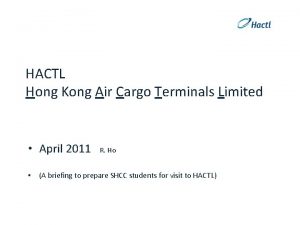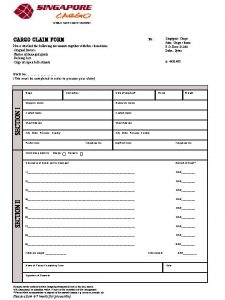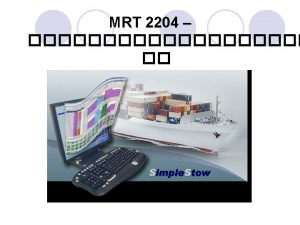Dry Cargo Calculations Dry Cargo Calculations It would














- Slides: 14

Dry Cargo Calculations

Dry Cargo Calculations It would be logical for us to be able to calculate how much cargo can fit into a space, rather than relying on a guess; however lucky that guess may be.

Dry Cargo Calculations A couple of definitions: SF (Stowage Factor) the amount of space required to load 1 mt of a particular cargo. BS (Broken Stowage) the amount of space lost whilst loading the cargo, given as a %age.

Dry Cargo Calculations The SF should be given to you by the shipper, the BS would be determined by your experience. So dividing the space available by the amount needed for 1 mt (ie the SF) would give us the tonnes of cargo able to fit in the space.

Dry Cargo Calculations EG The vessel has 6000 m 3 space, has to load Bags of grain with a SF of 1. 5. How many tonnes can she load? 6000 / 1. 5 = 4000 mt. Equally, how much space will 2000 mt steel ingots SF = 0. 3 take up? 2000 x 0. 3 = 600 m 3.

Dry Cargo Calculations Let’s complicate things: Your space will be already calculated, but there will be two values: Bale Space is the space available for loading bales (ie bales approx 3 m. X 1. 5 m. X 0. 8 m), so they can’t fit in between the frames. Grain space is (obviously!) the space available where loose bulk grain will go, ie between frames behind pipes, ladders &etc.

Dry Cargo Calculations Bale Grain

Dry Cargo Calculations Practical differences between Bale & Grain? On the old General Cargo ships with all the framework inside the hold, it could be up to 500 m 3. The newer ships with square-shaped holds (eg container ships) with the framework in an adjacent tank, will be practically zero. So Bale Space is used for calculating with General Cargoes, Grain Space for Bulk Cargoes.

Dry Cargo Calculations “that looks easy enough, how can (will!!) I make it more difficult? ”

Dry Cargo Calculations “that looks easy enough, how can (will!!) I make it more difficult? ” By adding cargoes and BS to make it more complicated; I can’t do anything else.

Dry Cargo Calculations EG You have hold space of 9500 m 3, you have loaded 3600 mt steel beams with a SF of 1. 6; 1000 mt bags rice with a SF of 2. 2; How many bales of cotton with SF of 5 will fit in the remaining space? Allow a BS of 3% for the cotton.

Dry Cargo Calculations You have hold space of 9500 m 3, you have loaded 3600 mt steel beams with a SF of 1. 6; 1000 mt bags rice with a SF of 2. 2; How many bales of cotton with SF of 5 will fit in the remaining space? Allow a BS of 3% for the cotton. Space Steel 3600 x 1. 6 Rice 1000 x 2. 2 Remaining BS 3% Cotton SF = 5 Tons to load 9500 -5760 -2200 1540 -46. 2 1493. 8 /5 298. 76

Dry Cargo Calculations NB If I had said that the BS was overall, then: Space 9500 BS 3% 285 Remaining 9215 Steel 3600 x 1. 6= 5760 Rice 1000 x 2. 2 = 2200 Remaining 1255 Cotton SF @5 /5 Tonnes to load = 251 RTQ!!

Dry Cargo Calculations Easy aren’t they? NB a HNC question should cover the whole of this, definitions & calculations
 L would rather
L would rather Would rather question form
Would rather question form Structural steel connection calculations calculations
Structural steel connection calculations calculations Tts dry cargo handling
Tts dry cargo handling In dry docking, why is the transverse km will become zero.
In dry docking, why is the transverse km will become zero. Past perfect conditional
Past perfect conditional Would sooner would rather
Would sooner would rather Hong kong air cargo terminals limited
Hong kong air cargo terminals limited Liquid cargo cult
Liquid cargo cult Pengertian stowage plan
Pengertian stowage plan Delex dp world tracking
Delex dp world tracking Cargo
Cargo Cargo que ocupa
Cargo que ocupa Cretschmar cargo
Cretschmar cargo Cargo 365
Cargo 365
























